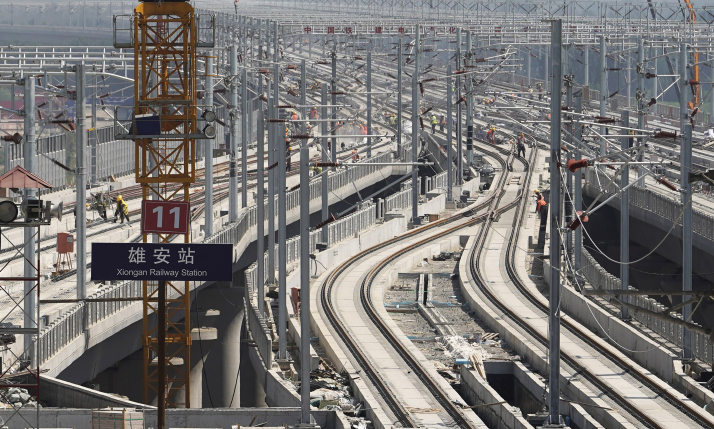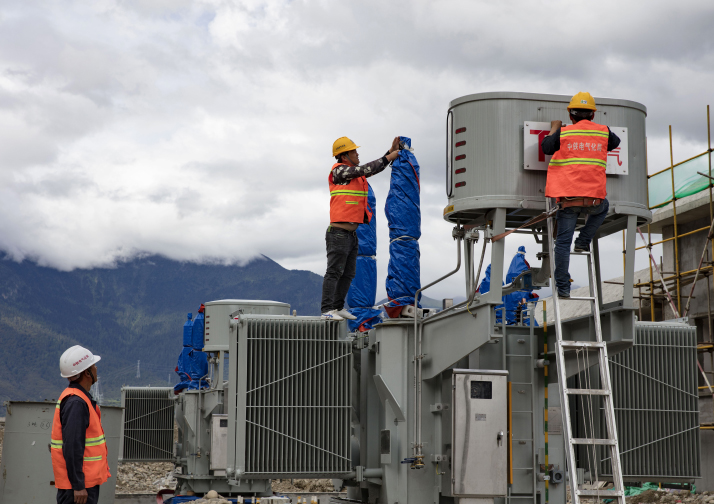| Business |
| Plan to build a modern railway network with international competitiveness and influence by 2035 | |
|
|
|
The last batch of 500-meter rails were laid down on August 17 for a high-speed intercity railway linking Beijing and Xiongan New Area in neighboring Hebei Province in north China, marking the beginning of the countdown to the line's full operation.
A key project for the coordinated development of the Beijing-Tianjin-Hebei region, the Beijing-Xiongan high-speed intercity railway is expected to come into full operation by the end of the year, shortening the travel time between Beijing and Xiongan from the current two hours to about one hour. This is a microcosm of China's recent blueprint to build a modern railway network, where commutes within cities will be limited to one hour by 2035. The upgraded travel system will also limit commutes within city clusters to two hours and between neighboring provincial capitals or city clusters to three hours. The country's top railway builder and operator, China State Railway Group (China Railway), unveiled the latest plan for railway construction on August 13 which will elevate China's global competitiveness in the railway sector by expanding railway networks with higher speed. It plans to build 200,000 km of railway by the end of 2035, a milestone year when China is set to realize basic socialist modernization. This means a 41-percent increase in intersecting rail lines, including about 70,000 km of high-speed tracks.  The construction site of the Beijing-Xiongan intercity railway in Xiongan New Area, Hebei Province in north China on July 24 (XINHUA)
Better connectivity According to the plan, all cities with a population of more than 200,000 will be connected to the railway network by then, and those with half a million residents will be linked by high-speed lines. Li Xing, a professor at Sichuan University, told 21st Century Business Herald that cities with 200,000 residents, mostly small and medium-sized, are located in central and western regions. The construction of railways will promote the flow of resources and boost local economies. "These cities are now experiencing accelerated development and will be the key to China's further urbanization," he added. Even the most remote cities, such as Kashgar in Xinjiang Uygur Autonomous Region, northwest China, and Xigaze in Tibet Autonomous Region, southwest China, will have access to high-speed railway services by 2035.  Technicians from China Railway Electrification Engineering Group work at the site of the power supply system of the Lhasa-Nyingchi Railway in Nyingchi, Tibet Autonomous Region in southwest China, on August 10 (XINHUA)
"Both regular and high-speed railways will continue to develop in an orderly manner, and in no case will the development of high-speed railways undercut the growth of regular speed trains," Ding Liang, an official with China Railway, said at a press conference on August 13. Meng Wei, spokesperson for the National Development and Reform Commission, said the Guangdong-Hong Kong-Macao Greater Bay Area will launch 13 intercity railway projects with a total length of about 775 km, as well as five integrated transportation hub projects. By the end of 2019, the area had a combined population of over 72.6 million, and is one of the most open and dynamic regions in China. Covering 56,000 square km, it consists of Hong Kong and Macao special administrative regions, as well as nine cities in Guangdong Province, south China. With an investment of 474 billion yuan ($68.4 billion), the latest construction plan will enable a multi-tier railway network in the Greater Bay Area along with the existing high-speed, regular and suburban railways, Meng said at a press conference in Beijing on August 17. It will shorten commutes between major cities in the area to one hour, while travel time from major cities to any prefecture-level city in Guangdong will be reduced to two hours and to neighboring provincial capitals to three hours. These projects will improve intercity traffic and support the integration of Hong Kong and Macao into the development of the country as a whole, as well as enhance connectivity between the Chinese mainland and Hong Kong and Macao, she added. Liang Dong, Deputy Director of the China Railway Economic and Planning Research Institute, said over the past two decades, China has built more than 700 high-speed railway stations and 126 railway logistics bases, forming comprehensive passenger and freight transport hubs. However, there is still a disconnect between different means of transport. For example, many airports and train stations are far from each other, adding time and hassle for passengers. As a result, the latest blueprint proposes boosting connectivity among various transport hubs with the integration of trunk, intercity, suburban railways and urban rail transit networks. China has intensified and will continue its efforts in research and the upgrading of train service to speeds of over 400 km/h. When the Fuxing bullet trains started their journey between Beijing and Shanghai in 2017, the maximum speed of bullet trains in China rose to 350 km/h. In June, the next-generation magnetic-levitation train conducted a successful test run, reaching a designed speed of 600 km/h. China's high-speed railway network topped 36,000 km at the end of July, accounting for more than two thirds of the world's total. It handled 3.66 billion passenger trips and carried 4.32 billion metric tons of cargo in 2019, an increase of 93.3 percent and 10.6 percent, respectively, compared to 2012, according to China Railway. In recent years, the China-Europe freight train has become a landmark achievement in Belt and Road cooperation, as well as an important logistics channel on the Eurasian continent. The number of freight trains running between China and Europe grew from 42 in 2012 to 8,225 in 2019, reaching 70 cities in 21 countries. As the China-Europe freight train becomes a world-renowned railway logistics brand, its international competitiveness and influence are expected to be enhanced. Dong Hui, an official with the company, said during the novel coronavirus pandemic, China-Europe freight trains have played a significant role in delivering medical supplies as well as stabilizing trade and supply chains. Moreover, investment in railway has been an important part of China's growth. Larry Hu, an economist with the Australian Macquarie Capital, told South China Morning Post that the blueprint reflects the nation's intention to sustain domestic growth through infrastructure spending. Fixed assets investment in railway was 325.8 billion yuan ($46.9 billion) in the first half (H1) of 2020, up 1.2 percent from H1 of 2019, even though the overall fixed assets investment fell 3.1 percent over the same period, according to China Railway. Further innovation By utilizing advanced technologies such as the BeiDou Navigation Satellite System and 5G communication technology, China plans to independently develop a new intelligent train control system to enhance operational efficiency and reduce energy consumption. "A large amount of electronic equipment has been installed along rail lines for train positioning and control in the traditional control system, which requires more maintenance and affects system reliability," Mo Zhisong, a chief engineer responsible for train control systems at China Railway, said on August 13. Once developed, the new intelligent system will require much less track-side electronic equipment and possibly none at all in the long run, he added. It will be more efficient since the current fixed-block signaling systems will be replaced by dynamic signaling commands. Mo said that in the new system, the safety distance will be based on a real-time calculation of train speed, while train intervals will be shortened from the current three minutes to two minutes, increasing transportation capacity by 30 percent. China Railway will also develop technologies such as environment sensing and automatic safety assessment to further reduce the need for manual operation, according to Mo. (Print Edition Title: A Railway Blueprint) Copyedited by Rebeca Toledo Comments to mamm@bjreview.com |
|
||||||||||||||||||||||||||||||
|